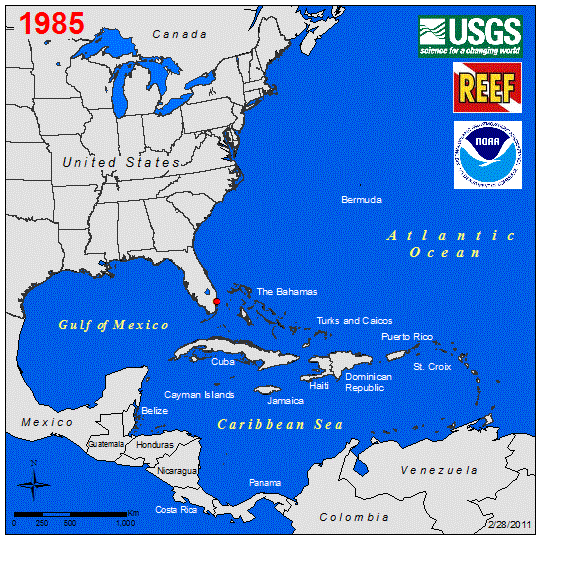By Mike Pursley
An unwelcome super-predator with venomous spines has found its way into the Northern Gulf of Mexico. Red Lionfish (Pterois voltans), a popular but hazardous saltwater aquarium pet was long presumed to be too warm-blooded to survive outside its distant tropical native range, over ten thousand miles away. However, divers and fishermen are increasingly catching live, healthy specimens off the southern coast of the United States, proving that cooler Gulf temperatures are not a barrier to this voracious and destructive feeder.
How did lionfish get into the Gulf of Mexico?
Hurricane Andrew shattered a Miami seaside aquarium containing several lionfish in 1992. These fish, observed to be alive in the harbor after the storm formed the first documented release. However, anecdotal reports suggest that lionfish might have been stocked illegally into Florida’s Atlantic waters several years earlier by those who wished to profit from capturing and selling the offspring. Whatever the source, these formerly captive fish were so successful in their new habitat, that by 2002, established populations could be found all along the East coast from South Florida to as far North as Cape Hatteras, North Carolina.
In three years, around 2005, lionfish territory had expanded southeast to include all Bahamian waters and several places in the Caribbean Sea. Two years later, in 2007, the number of reports of invading lionfish in the Caribbean had exploded. With few, if any, natural predators, there has been nothing to stop the spread of this aggressive fish. This assault progressed to the southern Gulf of Mexico and Western Florida with sightings becoming numerous in 2009. Now, in 2010, lionfish have been caught off the coast of Alabama, Louisiana and Texas. Mississippi officials are preparing for the inevitability that their coastal fishing reefs will be the next victims.
This unusually fast rate of spread is due to some amazing reproductive advantages. Lionfish mature while small at less than one year of age and can spawn every four days. Females release up to two million eggs per year. Eggs and larvae can drift freely for many miles on ocean currents. In about a month, larval development is complete and hungry juvenile lionfish will stay, eat and grow into adult lionfish wherever the currents place them. What’s worse is that drifting larvae enables lionfish to seasonally reinfest and deplete native fish populations even in areas that are too cold for their year-round survival.

Appetite for Destruction
Lionfish use their large, showy pectoral fins to efficiently herd and corner prey before rapidly consuming them whole. Adults can grow to more than two pounds and can consume fish up to 11” in length. Stomachs can expand during feeding up to thirty times the initial volume. Divers have observed a single lionfish eating 20 prey items in a 30 minute period. In addition to smaller reef fish, lionfish also eat shrimp, crabs, spiny lobster juveniles as well as young grouper, snapper and sea bass.
A fear among biologists is that lionfish will deplete the fish species that keep reefs clean of excess algae thereby posing a major threat to the survival of entire underwater ecosystems. Research findings indicate an 80% decrease in reef fish population can occur in just five weeks after a single lionfish introduction. Long
term environmental and economic effects to the Gulf of Mexico are currently unknown.
Biting Back
In their native range, lionfish are not particularly abundant or destructive. Studies are underway to find out what keeps them in check and if anything can be done to ease the problem here. In the meantime, everyone can help by spreading the word about the lionfish invasion, reporting all sightings and by not releasing any caught lionfish back into the water alive.
The good news is that lionfish are tasty whether baked, broiled, fried, grilled or sautéed. Community-level diving and fishing round-ups, concluding with a freshly-caught lionfish lunch or dinner afterwards, are becoming increasingly common social events in affected coastal areas. Up-scale restaurants are starting to offer lionfish on the menu as an environmentally friendly “conservation dish.” Eradication through fishing is considered improbable but it is the only tool currently available for control.
Taming Lions
Handle caught lionfish carefully by the head while wearing heavy gloves to prevent injury. Cut the spines off as closely as possible with wire cutters before cleaning to reduce the risk of stings. Venom is only stored within the spine structure. The heat of cooking destroys any residual toxins.
Lionfish stings cause very painful swelling and can potentially be serious depending on the severity and health of the victim. Seek prompt medical attention to prevent secondary infection or other complications. Use a hot water immersion with temperatures of 100 to 110 degrees F for 15-20 minutes or heat packs to ease the pain as a first-aid measure.
Lionfish Medical Treatment
[easy-social-share]
